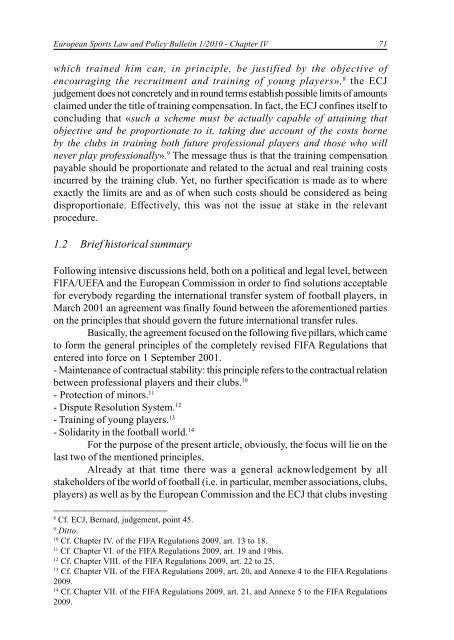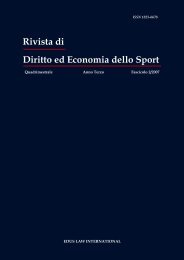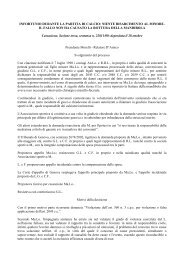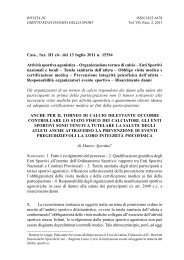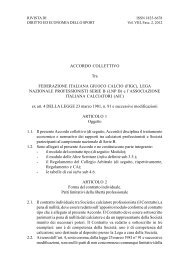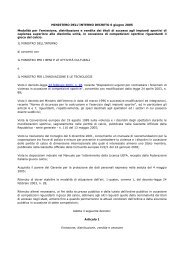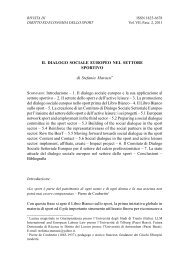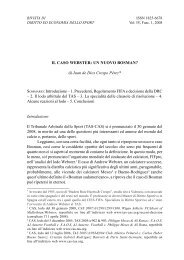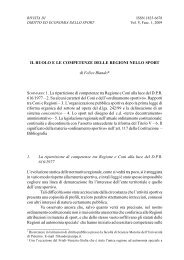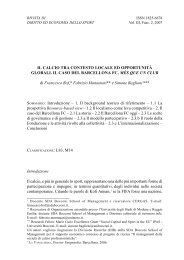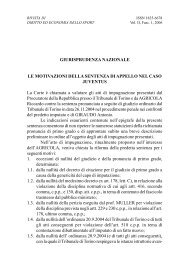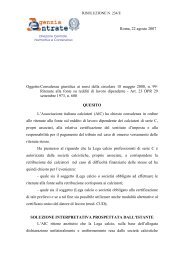European Sports Law and Policy Bulletin THE BERNARD ... - Slpc.eu
European Sports Law and Policy Bulletin THE BERNARD ... - Slpc.eu
European Sports Law and Policy Bulletin THE BERNARD ... - Slpc.eu
Create successful ePaper yourself
Turn your PDF publications into a flip-book with our unique Google optimized e-Paper software.
<strong>European</strong> <strong>Sports</strong> <strong>Law</strong> <strong>and</strong> <strong>Policy</strong> <strong>Bulletin</strong> 1/2010 - Chapter IV 71which trained him can, in principle, be justified by the objective ofencouraging the recruitment <strong>and</strong> training of young players», 8 the ECJjudgement does not concretely <strong>and</strong> in round terms establish possible limits of amountsclaimed under the title of training compensation. In fact, the ECJ confines itself toconcluding that «such a scheme must be actually capable of attaining thatobjective <strong>and</strong> be proportionate to it, taking due account of the costs borneby the clubs in training both future professional players <strong>and</strong> those who willnever play professionally». 9 The message thus is that the training compensationpayable should be proportionate <strong>and</strong> related to the actual <strong>and</strong> real training costsincurred by the training club. Yet, no further specification is made as to whereexactly the limits are <strong>and</strong> as of when such costs should be considered as beingdisproportionate. Effectively, this was not the issue at stake in the relevantprocedure.1.2 Brief historical summaryFollowing intensive discussions held, both on a political <strong>and</strong> legal level, betweenFIFA/UEFA <strong>and</strong> the <strong>European</strong> Commission in order to find solutions acceptablefor everybody regarding the international transfer system of football players, inMarch 2001 an agreement was finally found between the aforementioned partieson the principles that should govern the future international transfer rules.Basically, the agreement focused on the following five pillars, which cameto form the general principles of the completely revised FIFA Regulations thatentered into force on 1 September 2001.- Maintenance of contractual stability: this principle refers to the contractual relationbetween professional players <strong>and</strong> their clubs. 10- Protection of minors. 11- Dispute Resolution System. 12- Training of young players. 13- Solidarity in the football world. 14For the purpose of the present article, obviously, the focus will lie on thelast two of the mentioned principles.Already at that time there was a general acknowledgement by allstakeholders of the world of football (i.e. in particular, member associations, clubs,players) as well as by the <strong>European</strong> Commission <strong>and</strong> the ECJ that clubs investing____________________8Cf. ECJ, Bernard, judgement, point 45.9Ditto.10Cf. Chapter IV. of the FIFA Regulations 2009, art. 13 to 18.11Cf. Chapter VI. of the FIFA Regulations 2009, art. 19 <strong>and</strong> 19bis.12Cf. Chapter VIII. of the FIFA Regulations 2009, art. 22 to 25.13Cf. Chapter VII. of the FIFA Regulations 2009, art. 20, <strong>and</strong> Annexe 4 to the FIFA Regulations2009.14Cf. Chapter VII. of the FIFA Regulations 2009, art. 21, <strong>and</strong> Annexe 5 to the FIFA Regulations2009.


